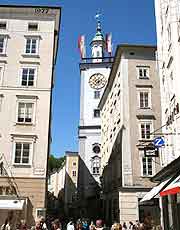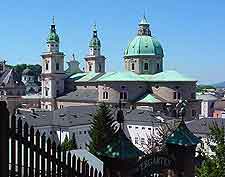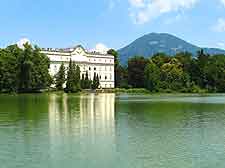Salzburg History Facts and Timeline
(Salzburg, Austria)

The history of Salzburg is a lengthy one, with remains of ancient Neolithic settlements being unearthed. During the 5th century BC, the Celts arrived and began to make this part of Austria their home.
A few centuries later, it was the era of the Romans and various settlements around the Salzburg area were successfully amalgamated as a single entity, with this small town being named Juvavum and becoming part of the Roman Empire. By the middle of the 1st century AD, Juvavum was referred to as a 'municipium' (Latin for town or city) and belonged to the kingdom of Noricum.
Decline and Rise of the City
Juvavum prospered for several centuries and the community began to grow in size. However, problems with the Norican frontier resulted in a rapid decline and by the arrival of the 8th century, this former thriving city was little more than a collection of ruins. Soon after, Salzburg witnessed the arrival of St. Rupert, who is widely regarded as being the official founder of the city. A basilica was constructed on the banks of the Salzach River and the city of Juvavum was renamed as 'Salzburg'. This name literally translates as 'Salt Castle' and derives from the frequent river barges laden with salt.
The city of Salzburg soon began to expand its boundaries, with many houses and buildings erected during this era of history. In 1077, the famous Festung Hohensalzburg (Hohensalzburg Fortress) was built and this elevated castle still stands today as an important monument to the past, with museums, torture chambers and splendid staterooms all waiting to be explored by tourists.

A Period of Independence and Religious Dissension
In the latter part of the 14th century, the city managed to secure its independence from the German state of Bavaria, becoming the seat for the ecclesiastical state known as the Archbishopric of Salzburg, a part of the Holy Roman Empire. The year of 1622 saw the arrival of the University of Salzburg, which is also often known as the Paris Lodron University and is today called home by more than 14,000 students.
As with so many cities in history, differences in religious beliefs began to divide the community. In 1731, Roman Catholic Bishop of Lavant, Leopold Anton Eleutherius Von Firmian (the then Prince Archbishop of Salzburg) decreed that all Protestants residing within the city should either adopt Catholic beliefs, or be expelled.
Protestant landowners had just a matter of days in which to sell up, being ordered to leave all of their livestock at the market. Chunks of land were taken by Von Firmian for his own personal use, adding to his power and considerable wealth, and Protestant bibles were burnt in front of the locals. When the harsh winter weather was drawing to an end, landowners packed up their bags and left for a new life elsewhere, although many families of miners, tradesmen and general labourers had already left. Some young children were forcibly detained in Salzburg, so that they could adopt the Roman Catholic faith.
Highwaymen robbed many of those who were banished whilst they walked towards neighbouring German cities, looking for shelter. The following year saw Frederick William I, King of Prussia, welcome some 12,000 of these emigrants to replenish the local population, since East Prussia had suffered terrible losses at the hands of the plague in recent years.
A Change of Ownership
At the beginning of the 19th century, Emperor Napoleon played an important part in the history of Salzburg. His victorious battles resulted in Salzburg coming under the rule of Ferdinand III, Grand Duke of Tuscany in 1803. Just two years later, the city finally became a part of Austria, albeit relatively briefly, returning to the control of Bavaria in 1809. Following the 1815 Congress of
Vienna, the German border was moved and Salzburg has been a part of Austria ever since.

The World Wars
At the end of the First World War, Salzburg belonged to the Republic of German-Austria, while in 1919, the Treaty of Versailles saw ownership transferred to the First Austrian Republic. World War II witnessed German troops occupy much of the city, with Jewish residents and further minorities being arrested and detained in nearby concentration camps. Allied bombing caused tremendous damage, destroying just under 50 percent of all the houses and buildings in Salzburg, with over 500 Austrians being killed. American troops arrived in the city in 1945 to herald the end of the war, and a well-planned reconstruction project soon commenced.
Tourism in the City of Today
Nowadays, Salzburg enjoys a healthy tourist industry, with visitors arriving to admire its various attractions and learn all about its history within its plentiful museums. The Mozarts Geburtshaus (Mozart Museum) is especially popular and details the life of acclaimed Austrian composer, Wolfgang Amadeus Mozart, who was actually born in Salzburg in 1756.
The Old Town is a particularly historic part of the city, becoming a World Heritage Site in the middle of the 1990s. Here you will find sights such as the Getreidegasse, the Nonnberg Abbey, the Residenz Palace, the Salzburger Dom (cathedral) and St. Peter's Abbey. Of course, hordes of tourists also come to enjoy the city's Sound of Music heritage, since this classic Rodgers and Hammerstein movie was filmed here in the 1960s.
 The history of Salzburg is a lengthy one, with remains of ancient Neolithic settlements being unearthed. During the 5th century BC, the Celts arrived and began to make this part of Austria their home.
The history of Salzburg is a lengthy one, with remains of ancient Neolithic settlements being unearthed. During the 5th century BC, the Celts arrived and began to make this part of Austria their home.
